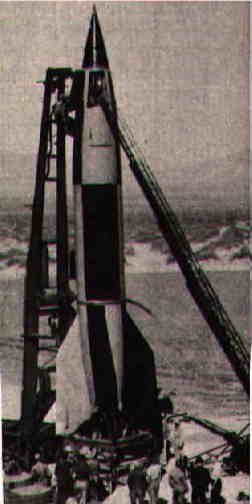V2 Rocket
 American technicians prepare a captured German V-2 rocket at White Sands, New Mexico after World War II.
American technicians prepare a captured German V-2 rocket at White Sands, New Mexico after World War II.
 The V-2 was 14 meters high and could hit a target 322 kilometers away. It was the first practical liquid fueled rocket which could reach above the atmosphere.
The V-2 was 14 meters high and could hit a target 322 kilometers away. It was the first practical liquid fueled rocket which could reach above the atmosphere.

On October 3, 1942, the space age began with the successful launch of the V-2 on its third attempt and the world would never be the same. Made as a weapon of war and not for science or adventure, the 46 foot alcohol and liquid oxygen V-2 had a velocity of 3500 mph and could carry a 1,650 pound warhead to a range of 200 to 250 miles. It is the ancestor of practically every rocket flown in the world today and, in September of 1944, was launched against England toward London but came too late to affect the outcome of the war.
In January of 1945, Von Braun knew the war was over and made plans to move his team of about 125 rocket scientists and engineers south to surrender to the Americans. Hitler had ordered their execution to prevent their capture by the Allies. On the same day that Berlin fell to the Soviet Army, May 2, 1945, Von Braun and his rocket team entered the American lines to safety. "Project Paperclip" was instituted to find as many German rockets, scientists and engineers as possible and enough parts were found to build 100 V-2's.
By February of 1946 all the German rocket scientists were moved to White Sands, New Mexico and on April 16, 1945 the first of the captured V-2's was launched in the United States. This signaled the start of the U.S. space program or, at the very least, the ballistic missile program. The most memorable launching at White Sands, however, came on February 24, 1949, when a V-2 boosted a WAC Corporal rocket developed by the Jet Propulsion Laboratory 244 miles into space and to a speed of 5,510 miles per hour, the greatest altitude and velocity yet attained by a man-made object.
Back to Rocket Museum